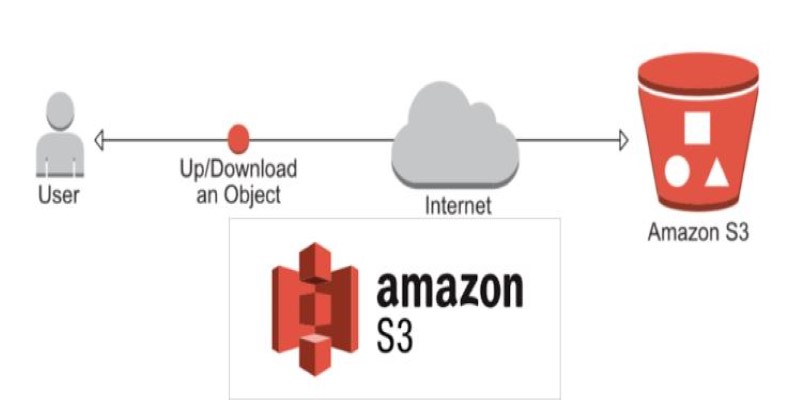Advertisement
Amazon S3, or Simple Storage Service, has become one of the most widely used cloud storage solutions since its release in 2006. It offers a reliable way to store and access data on the web, whether for hosting website files, keeping backups, or storing application data. Its popularity comes from its simplicity — easy to set up, scalable, and dependable. Individuals and businesses use it because it just works, handling everything from small projects to global operations. This guide explains what Amazon S3 is, how it works, and why so many people trust it.
Amazon S3 is a cloud-based service that lets you store and access your data anytime, from anywhere with an internet connection. Unlike the usual folder-and-drive structure you're used to on a computer, S3 organizes your files into "buckets," and each file, called an "object," gets its unique key. This simple system makes it easy to keep track of everything, no matter how much you upload.

What makes S3 stand out is how it protects your data. Every file you save is automatically duplicated across several servers in Amazon’s regional data centers. Even if one server or building fails, your files stay safe and accessible. Amazon even boasts eleven nines of durability, which means the chance of losing a file is almost zero.
You also have complete control over who can view your data. Files can be entirely private, shared via secure links, or posted publicly if you wish. This flexibility suits everything from sensitive backups to making open files available on a website.
Amazon S3 offers several storage classes to suit how you use your data. The most common is Standard, which is ideal for files you need to access often, such as website media or active project files. For less-used data, Infrequent Access (IA) provides lower costs while keeping files available when needed. For archives, Glacier and Glacier Deep Archive are much cheaper, designed for data you rarely access.
Pricing depends on more than just how much data you store. It also factors in how often you access it, how much you transfer out, and the number of operations performed. However, it’s pay-as-you-go, meaning you only pay for what you actually use. Many users create cost estimates with Amazon’s calculator before committing large amounts of data.
S3 makes it easy to save money over time by automating storage changes. You can set lifecycle rules to move files to cheaper classes as they age — for example, moving backups from Standard to Glacier after 30 days. This way, you can keep costs predictable and low without constant manual changes.
Amazon S3 includes features that go beyond simple storage. Versioning keeps old copies of your files instead of deleting them outright, which helps if you overwrite something by mistake. Encryption protects your data both in transit and at rest, and you can choose whether to handle it yourself or let Amazon manage it. Fine-grained access controls through AWS Identity and Access Management (IAM) make it easier to decide who can see and change specific files or buckets.

S3 integrates with other AWS services seamlessly. Many websites use it to serve static content like images and downloads. Others use it as a data lake for analytics, a place to store IoT data, or a backup target for servers. It scales automatically, so whether you store a few files or petabytes of data, it performs the same.
Reliability is a big reason people choose S3. Data is distributed across multiple facilities within a region, ensuring high availability. For those needing extra resilience, cross-region replication allows you to copy data to another part of the world. These features make it a dependable choice for business-critical and personal projects alike.
Setting up and using Amazon S3 is straightforward, even for beginners. You start by creating a bucket in your chosen AWS region. Then you upload your files, either through the web console, the AWS CLI (command-line interface), or programmatically via APIs. Permissions can be adjusted so that only you, specific users, or the public can access certain files.
For developers, S3 integrates seamlessly with other AWS services. You can connect it to CloudFront for faster content delivery, use Lambda to process files automatically when they’re uploaded, or hook it into AWS Athena to query data stored in S3 directly. These integrations make it easier to build more advanced workflows without needing separate storage or processing systems.
For those concerned about security, Amazon provides tools to audit access logs, enforce encryption policies, and set up alerts if someone modifies permissions or deletes files unexpectedly. Many of these controls can be automated, so you don't have to constantly monitor the service yourself.
For anyone already using AWS for compute or networking, S3 feels like a natural fit. Its simplicity hides a lot of engineering behind the scenes, letting you focus on your work rather than worrying about hardware or maintenance. For those not tied to AWS, it still offers a reliable and flexible cloud storage option that’s hard to match in terms of durability and global reach.
Amazon S3 stands out as a dependable and flexible cloud storage service that’s easy to set up and manage. With its range of storage classes, built-in security, and simple pricing, it works just as well for small personal projects as for large enterprises. Its high durability and seamless integration with other tools make it an attractive choice for storing and accessing data. Whether you’re hosting files for a website, archiving records, or building an analytics system, Amazon S3 offers a practical way to keep your data safe, accessible, and scalable without unnecessary complexity or steep learning curves.
Advertisement

Discover effective machine learning techniques to handle missing data in time-series, improving predictions and model reliability

Open models give freedom—but they need guardrails. Constitutional AI helps LLMs reason through behavior using written principles, not just pattern-matching or rigid filters

How a humanoid robot learns to walk like a human by combining machine learning with advanced design, achieving natural balance and human-like mobility on real-world terrain

Find how AI is reshaping ROI. Explore seven powerful ways to boost your investment strategy and achieve smarter returns.
Advertisement

Tired of reinventing model workflows from scratch? Hugging Face offers tools beyond Transformers to save time and reduce boilerplate

How the AI-enhancing quantum large language model combines artificial intelligence with quantum computing to deliver smarter, faster, and more efficient language understanding. Learn what this breakthrough means for the future of AI

Speed up Stable Diffusion Turbo and SDXL Turbo inference using ONNX Runtime and Olive. Learn how to export, optimize, and deploy models for faster, more efficient image generation

Explore what large language models (LLMs) are, how they learn, and why transformers and attention mechanisms make them powerful tools for language understanding and generation
Advertisement

How Amazon AppFlow simplifies data integration between SaaS apps and AWS services. Learn about its benefits, ease of use, scalability, and security features

Learn the top 8 Claude AI prompts designed to help business coaches and consultants boost productivity and client results.

EY introduced its Nvidia AI-powered contract analysis at Mobile World Congress, showcasing how advanced AI and GPU technology transform contract review with speed, accuracy, and insight

How machine learning is transforming sales forecasting by reducing errors, adapting to real-time data, and helping teams make faster, more accurate decisions across industries